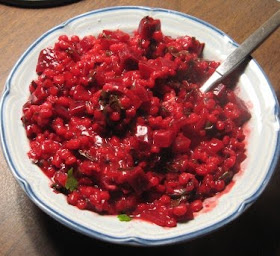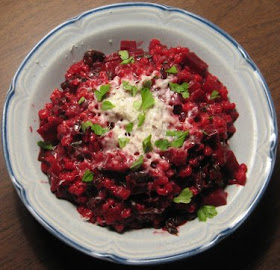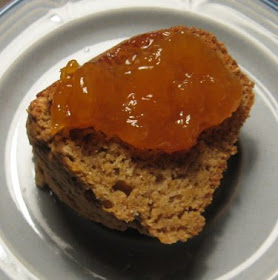
Yes! So John was in CA again last week. While on many levels this is not at all a great situation (and, for the record, I am so glad video chat is now just standard and available), it does mean I get to cook whatever I want, complete with maniacal laughter.
So. Beets. I had a couple in the vegetable drawer. I also had red chard, which is pretty much a given vegetable at our house on any occasion, and barley. Clearly this was an excellent opportunity to stain the cutting boards bright fuchsia. I made beet risotto.
As mentioned, I always only make risotto with barley anymore. Wow, that was a ridiculous grammatical arrangement! However, it is true. No more arborio rice. Barley works just as well, and is both cheaper and healthier. I suppose I should figure out the official term for "barley cooked in the style of risotto" sometime soon, since "barley risotto" is too much of a lingual mishmash. Babelfish says the Italian term for barley is "orzo," but using that to create the term "orzotto" would be confusing for English speakers who only know orzo as a pasta. The only other word I can find is the French "orgetto," which appears to be a created hybrid itself. I think I'm going to stay with the classic title, since risotto requires the same procedure no matter which grain you choose.
Beet risottoolive oil/butter
onion
barley/arborio rice
white wine/dry vermouth
veg broth
beets
chard
salt, pepper
parmesan/other grating cheese if you want it
fresh parsley
Right! For risotto, you always want to make your broth first. So fill a smaller pot with a selection of vegetable trimmings and several cups of water. Since we're making beet risotto, you definitely want a beet-oriented broth; to achieve this, scrub and peel your beets, then add the peels and other trimmings to the broth pot. Bring the business to a boil, then cover and let simmer while you're orchestrating everything else.
For the main event, follow the same steps as with any risotto. That is to say, first get out a good deep pan and warm some olive oil in it. You can use butter instead, or mix oil and butter; whatever floats your boat. Or really, whatever you have in the house.
Peel and dice an onion, putting the trimmings into the broth pot. Add the diced onion to the oil/butter/whatever, stir it up, and let it cook on medium until softened. While the onion is cooking, you can dice your peeled beets or wash a bunch of chard. Multitasking for the win!
Next, add a cup of pearl barley and a cup of white wine to the risotto pan. Stir it up, turn the heat up a touch, and let it cook. Contrary to popular opinion, you do Not need to sit there and stir risotto absolutely constantly. Just give it a few stirs every couple minutes and you should be fine.
When the barley has absorbed most of the wine and the pan is beginning to get dry, scoop a cup or so of liquid out of the broth pan. I do this by lowering a measuring cup with the mouth against the side of the pan, so only the liquid gets in. It's not hard, and doesn't require straining the entire pot before you can use the broth. So! Dump the broth in the risotto pot and cook as before, stirring frequently. When the broth is absorbed, add another cupful and repeat. Add more water to your broth pan as needed--it should have plenty of time to come to a simmer from one broth addition to the next. For those of you who are clearly skeptical of such a mid-simmer addition: I do this all the time, and it works fine.
Between bouts of stirring, make sure your beets are all diced. I used one gigantic softball-sized beet, which gave me enough beet content for several people. Also, trim your chard and cut the leaves off the stems. Chop the stems finely and the leaves coarsely. Definitely keep them in separate piles!

After maybe the third broth addition, your barley should be about halfway cooked. You can tell by looking at the grains: there should be a translucent ring around a solid core. When you get to this point, add both another cup of broth and your diced beets to the risotto. Stir it up and keep cooking as before. After another round of broth, add the chard stems. Notice how violently pink the entire business has become by this point. PINK!!
The barley should start to look thoroughly cooked pretty soon now. Taste a grain or two if you aren't sure. Just keep on with the broth additions until it's done. The whole cooking procedure should take about a half hour altogether.
Ok! Take the pan off the heat and stir in the chopped greens. They should wilt into the barley pretty quickly. Add a good lot of cracked black pepper and a tiny pinch of salt. If you want cheese, grate a pile and stir it into the risotto as well. If you aren't using cheese, you can use more salt, since cheese is generally salty. Definitely add lots of pepper, though; beets are sweet, and chard tastes like super iron spectacular, so it's nice to have some spice to balance them out.
Now put it in a bowl, sprinkle a good pinch of fresh parsley leaves and maybe a little more cheese over the top, and eat it.

Note the extremely high color contrast. Don't wear white clothing while you're eating beet risotto. I'm just saying.
Evidently the glorious healthy deliciousness of risotto was not enough for me, however! After I finished eating, I went straight back into the kitchen and made a bundt cake.

I know! But I wanted cake, and I had sufficient ingredients, so I baked a cake and I ate it. Well, not the entire cake, but still. I certainly ate a reasonable amount of it.
This one was an unveganized version of
jae steele's lemon poppyseed cake, from her cookbook
Get it Ripe. I tend to make lots of unveganized versions of the baked goods in vegan cookbooks for some reason. In this case, I had actual plain yogurt but no soymilk, so I just subbed the yogurt directly for the milk. I also left out the poppyseeds, since none of those were hiding in the cupboard, and used whole wheat flour instead of spelt. The resulting batter was thick and unpourable, but very easily scoopable. I had zero issues getting it arranged in the pan.

The end result was definitely fine and lemony and delicious and damp. I had mine with my heritage cake topping: apricot jam. Lemon cake and apricot jam definitely win.
In the morning, I made some of my massive amount of leftover risotto into risotto cakes for breakfast. Warm a nonstick pan with a tiny bit of olive oil, fry spoonfuls of risotto on both sides, then maybe melt a thin slice of cheese over the top: done.

Clearly, it was a pretty rewarding night of cooking.